Salvia forskaohlei
(S. forskahlei, S. forsskaolii)
|
![]()
Links to Other World of Salvia Pages:
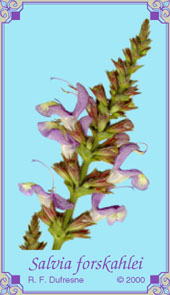 |
Forskahl's Sage This speciesí name is currently spelled in a number of different ways. The frequency that these variants appear on the Google search engine is: S. forskahlei (11), S. forsskaolii (10), S. forskaohlei (59). For further discussion of its name, see my help page. As a garden subject, it is rather durable and can handle subtropical humidity fairly well. It is related to S. glutinosa, S. nubicola, and S. hierosolymitana. It is a bit hard to locate in the eastern part of the United States only because seed is not easily collected and germinates irregularly. Otherwise, it is a free blooming plant for most of the summer. In Mediterranean climates, it self-sows abundantly, but does not appear to be a garden thug. ©2000 by Richard F. Dufresne |
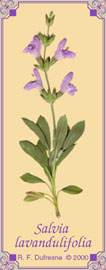 |
Spanish Sage A true Mediterranean plant, this sage is closely related to common garden sage, and has similar horticultural needs. It needs to be brought out of the cold in northern states. It is a smaller, more tidy plant with a pleasant scent and is grown for its essential oil. As such, it is the European equivalent of S. clevelandii. The dwarf forms of garden sage (S. officinalis) are likely derived in part from this species. ©2000 by Richard F. Dufresne |
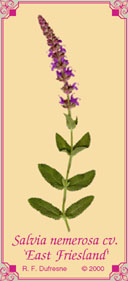 |
`East Friesland' Meadow Sage This is the work horse sage for northern gardens. Of all the forms of this sterile hybrid, it is easily the most durable, withstanding subtropical humidity for at least three years. Blooming in late spring, it thrives as a no maintenance plant. Deadheading in early summer will promote modest re-blooming later. Like all the smaller flowered forms of section Plethiosphace (meadow sage group), it is a favorite of honey bees. There are a growing number of new forms of this sage being released each year. ©2000 by Richard F. Dufresne |
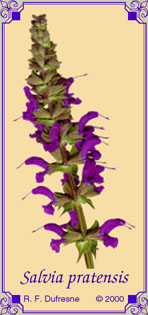 |
Blue Meadow Sage This is a good beginnerís sage. It is easy from seed, and forms a robust bush in two years. Its large blue to indigo flowers attract bumblebees and is one of the first sages to bloom in spring. Even though seed is produced abundantly, it is not a thug. There are a number of variants, mostly foliage and flower color variations (reds and whites). The desirable S. haematodes is either closely related or a form of this species, and the cultivar with silvery lilac flowers is especially nice. Its flowers are also variable in color. ©2000 by Richard F. Dufresne |
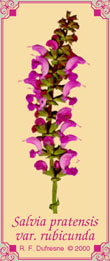 |
Rose Meadow Sage This cultivar of meadow sage has rich red flowers with a touch of purple. It is best propagated by seed, with no other flower color forms of meadow sage nearby. Plants should be grown out until they bloom to assure that they have the proper color. The varietal name used above was that on the packet of seed I received. It may not be authentic. ©2000 by Richard F. Dufresne |
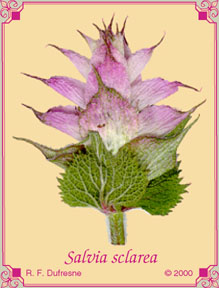 |
Clary Sage This is a favorite old-time sage. It forms handsome rosettes of wooly gray leaves and blooms its head off before it goes to seed in its second year. Its greatest show is not in the lavender and white flowers, but in the brilliant bracts. Its hairiness is a tipoff that it requires Mediterranean conditions for optimal growth. It is grown commercially for its resin, which contains sclareol. This scentless compound is a valuable starting material for the flavor and fragrance industry. Closely related species are S. aethiopis and S. argentea. See my help page for more information on how to tell the last two apart. ©2000 by Richard F. Dufresne |
Links to Other World of Salvia Pages:
![]()
|
Salvia forskahlei
|